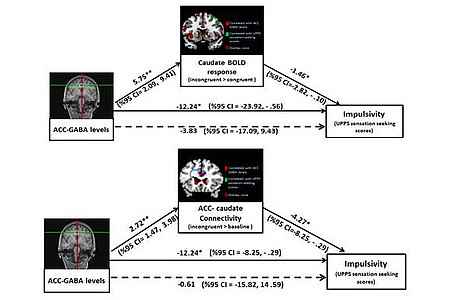You are here
Content
Our goal is to find multi modal imaging biomarkers for psychiatric diseases. We investigate the relation of the (in vivo detectable) Neurochemistry with other imaging modalities, amongst others neuronal function, functional connectivity, cognitive performance – in humans as well as in animal models of rodents and mice. We are especially interested in the relation between imaging marker and symptoms – independent of disease classifications.
Translationale imaging in animals aids to better understanding of the etiology of psychiatric diseases. The creation of imaging endophenotypes is expected to further the development of new medications.
For our imaging projects currently two 3 T Siemens TIM Trio scanners are available equipped with 32 receiver channels. One scanner additionally yields a multinuclear option. We developed and implemented new hardware for hyperscanning experiments to conduct simultaneous measurements at both scanners. Furthermore, the ZI hosts a 9,4T animal scanner which makes a substantial contribution to the translational research in psychiatry.
The focus of our work is on
- Development and establishment of new neuro MR imaging and spectroscopy methods and their combination and evaluation
- Pain processing in Borderline Personality Disorder; an imaging study on the changes in arterial cerebral blood flow induced by pain (stress versus non-stress condition) as well as an MR spectroscopic imaging study to investigate the relation between neurotransmitter concentrations of Glutamate and GABA with pain sensation
- Emotional stimuli and neurofeedback: Characterization of the neuronal response and development of a neurofeedback trainings for Borderline Personality disorder
- New development for fMRI in animals, e. g. Awake State fMRI, (DREADD)-fMRI, optogenetic (og)-FMRI
Selection of recent publications
- Wang GY, van Eijk J, Demirakca T, Sack M, Krause-Utz A, Cackowski S, Schmahl C, Ende G. (2017) ACC GABA levels are associated with functional activation and connectivity in the fronto-striatal network during interference inhibition in patients with borderline personality disorder. Neuroimage. 2016 Dec 7;147:164-174. doi: 10.1016/j.neuroimage.2016.12.013. [Epub ahead of print]
- Ende G, Cackowski S, Van Eijk J, Sack M, Demirakca T, Kleindienst N, et al. (2016): Impulsivity and Aggression in Female BPD and ADHD Patients: Association with ACC Glutamate and GABA Concentrations. Neuropsychopharmacology. 41:410-418.
- Paret C, Ruf M, Gerchen MF, Kluetsch R, Demirakca T, Jungkunz M, Bertsch K, Schmahl C, Ende G. (2016): fMRI neurofeedback of amygdala response to aversive stimuli enhances prefrontal-limbic brain connectivity. Neuroimage. 125:182-188.
- Demirakca T, Cardinale V, Dehn S, Ruf M, Ende G (2016): The Exercising Brain: Changes in Functional Connectivity Induced by an Integrated Multimodal Cognitive and Whole-Body Coordination Training. Neural plasticity. 2016:8240894.
- Wang GY, Demirakca T, van Eijk J, Frischknecht U, Ruf M, Ucar S, Hermann D, Mann K, Kiefer F, Ende G. (2016). Longitudinal Mapping of Gyral and Sulcal Patterns of Cortical Thickness and Brain Volume Regain during Early Alcohol Abstinence. European addiction research. 22:80-89.
- Ende G. (2015). Proton Magnetic Resonance Spectroscopy: Relevance of Glutamate and GABA to Neuropsychology. Neuropsychology review. 25:315-325.
- Paret C, Kluetsch R, Ruf M, Demirakca T, Kalisch R, Schmahl C, Ende G (2014). Transient and sustained BOLD signal time courses affect the detection of emotion-related brain activation in fMRI. Neuroimage, 103:522-32. 2014
- Sack M, Wetterling F, Sartorius A, Ende G, Weber-Fahr W. (2014) Signal-to-noise ratio of a mouse brain (13) C CryoProbe system in comparison with room temperature coils: spectroscopic phantom and in vivo results. NMR Biomed. 27:709-715
- Hermann D, Weber-Fahr W, Sartorius A, Hoerst M, Frischknecht U, Tunc-Skarka N, Perreau-Lenz S, Hansson AC, Krumm B, Kiefer F, Spanagel R, Mann K, Ende G, Sommer WH. (2012): Translational magnetic resonance spectroscopy reveals excessive central glutamate levels during alcohol withdrawal in humans and rats. Biol Psychiatry. 71:1015-1021.
Context Column
Contact

Prof. (apl.) Dr. Gabriele Ende
Department of Neuroimaging
Zentralinstitut für Seelische Gesundheit
J5
68159 Mannheim
Phone +49 621 1703-2971
gabi.ende@zi-mannheim.de

